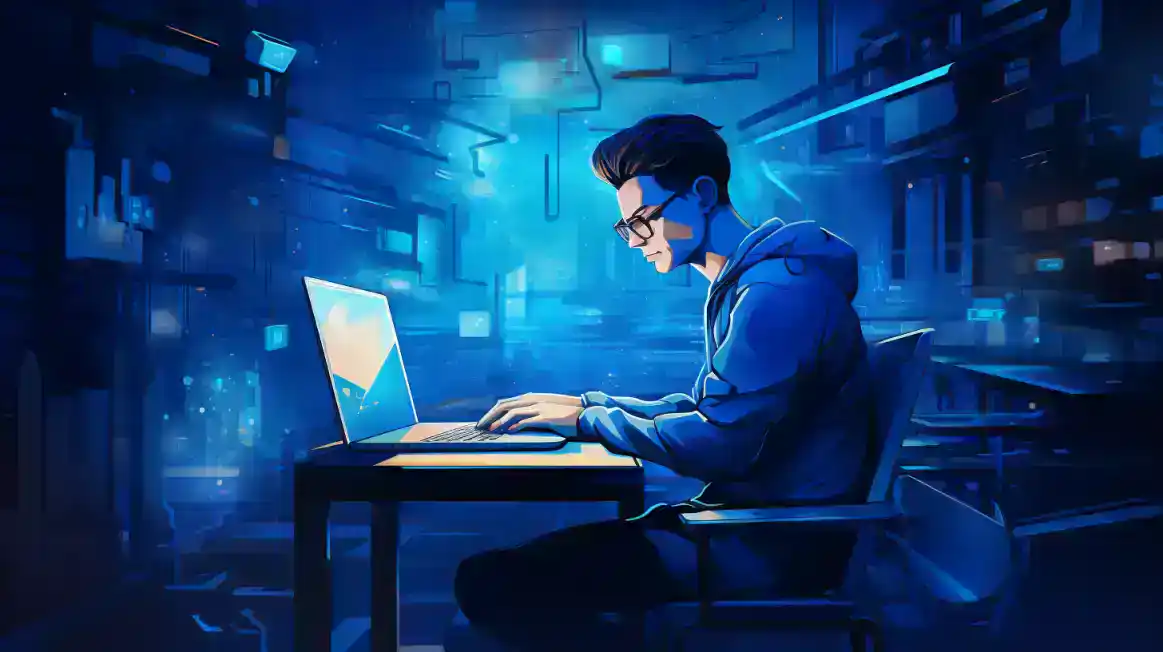Table of Contents
The world is changing faster than ever before. Technology is transforming every aspect of our lives, from how we communicate, work, learn, and play. The digital age offers unprecedented opportunities for innovation, creativity, and growth. But it also poses significant challenges for those who are not prepared to adapt and evolve.
How can we ensure that we are ready for the future? How can we keep up with the pace of change and stay relevant in the digital economy? How can we leverage technology to enhance our personal and professional development?
The answer is simple: we need to future-proof our digital adaptability.
Future-proofing is the process of anticipating and preparing for the changes that are likely to occur in the future. It involves developing the skills, mindsets, and strategies that will enable us to thrive in the digital age. Future-proofing is not about predicting the future, but rather about creating it.
But What is Digital Adaptability? And Why is it important?
Digital adaptability is the ability to learn and use new technologies, cope with change and uncertainty, and thrive in a fast-paced and dynamic environment. It is an important skill in the 21st century, as digital technologies are constantly evolving and transforming various domains and scenarios.
Digital adaptability can benefit you and your organization in many ways, such as:
- Increasing efficiency, productivity, and resilience. By learning and using new technologies, you can automate and optimize various tasks and processes, save time and resources, and overcome challenges and obstacles.
- Enhancing customer engagement and responsiveness. By adapting to changing customer needs and preferences, you can create and deliver personalized and relevant products and services, communicate and interact with customers effectively, and build trust and loyalty.
- Fostering innovation and creativity. By experimenting with new ideas and solutions, you can discover and exploit new opportunities, solve problems improve performance, and create value and differentiation.
- Gaining a competitive edge and achieving growth. By staying ahead of the curve and the competition, you can capture and retain market share, expand to new markets and segments, and increase revenue and profitability.
In this blog post, we will explore four key strategies that will help you future-proof your digital adaptability and achieve your goals in the digital age. These are:
- Cultivating a growth mindset
- Mastering essential digital skills
- Embracing emerging technologies
- Fostering a collaborative and adaptable culture
Let’s dive in!
Cultivating a Growth Mindset

One of the most important factors that determines our digital adaptability is our mindset. Our mindset is the way we think about ourselves, our abilities, and our challenges. It influences how we approach learning, problem-solving, and decision-making.
There are two types of mindsets: fixed and growth. A fixed mindset is the belief that our intelligence, talents, and skills are fixed and cannot be changed. A fixed mindset leads us to avoid challenges, give up easily, ignore feedback, and feel threatened by the success of others. A fixed mindset limits our potential and hinders our digital adaptability.
A growth mindset is the belief that our intelligence, talents, and skills can be developed through effort, learning, and feedback. A growth mindset leads us to embrace challenges, persist in the face of obstacles, seek feedback, and celebrate the success of others. A growth mindset enhances our potential and boosts our digital adaptability.
To future-proof our digital adaptability, we need to cultivate a growth mindset. A growth mindset will enable us to learn new skills, adapt to new situations, and take on new challenges. A growth mindset will also help us cope with uncertainty, ambiguity, and change, which are inevitable in the digital age.
Here are some practical tips for fostering a growth mindset:
- Seek out new experiences that challenge you and push you out of your comfort zone. For example, you can take up a new hobby, learn a new language, or enroll in an online course.
- Embrace feedback as an opportunity to learn and improve. Ask for constructive feedback from your peers, mentors, or coaches, and use it to identify your strengths and areas for improvement.
- Celebrate your progress and achievements, no matter how small. Recognize the effort and persistence that you put into your learning and development. Reward yourself for reaching your milestones and goals.
Mastering Essential Digital Skills

Another key strategy for future-proofing our digital adaptability is mastering essential digital skills. Digital skills are the abilities that enable us to use technology effectively and efficiently. Digital skills are not only about knowing how to operate a computer or a smartphone, but also about understanding how to navigate, communicate, and create in the digital world.
There are two levels of digital skills: digital literacy and digital fluency. Digital literacy is the basic level of digital skills, which includes the ability to use common digital devices, applications, and platforms. Digital literacy is the foundation for digital adaptability, as it allows us to access, consume, and share information and content online.
Digital fluency is the advanced level of digital skills, which includes the ability to use digital tools and platforms to create, analyze, and manipulate information and content. Digital fluency is the key to digital adaptability, as it allows us to leverage technology to enhance our productivity, efficiency, and innovation.
To future-proof our digital adaptability, we need to master both digital literacy and digital fluency. We need to develop the foundational digital skills that will enable us to perform basic tasks and functions online, as well as the advanced digital skills that will enable us to create value and solve problems online.
Embracing Emerging Technologies

A third strategy for future-proofing our digital adaptability is embracing emerging technologies. Emerging technologies are the new and innovative technologies that are transforming the world and creating new possibilities and opportunities. Some examples of emerging technologies are artificial intelligence, machine learning, automation, blockchain, and biotechnology.
Digital signage is an area where emerging technologies are making a significant impact. For instance, digital signage systems now incorporate AI for content optimization, IoT for remote management, and advanced analytics for measuring engagement. By staying informed about the latest signage hardware selection, businesses can make more informed decisions, improve communication effectiveness, and adapt quickly to changing market needs.
Emerging technologies have the potential to improve our lives, enhance our work, and solve our problems. They can also disrupt our industries, challenge our norms, and create new risks. Therefore, we need to embrace emerging technologies with curiosity, openness, and awareness.
To future-proof our digital adaptability, we need to embrace emerging technologies and learn how to use them to our advantage. We need to understand the benefits and challenges of emerging technologies, and how they can impact our personal and professional goals. We also need to explore the ethical, social, and environmental implications of emerging technologies, and how we can use them responsibly and sustainably.
Here are some examples of how we can embrace emerging technologies and leverage them to enhance our digital adaptability:
- Artificial intelligence (AI) and machine learning (ML) are technologies that enable machines to perform tasks that normally require human intelligence, such as recognition, reasoning, and decision-making. We can use AI and ML to automate repetitive and mundane tasks, augment our capabilities, and generate insights and predictions.
- Automation is the technology that enables machines to perform tasks without human intervention, such as manufacturing, transportation, and service delivery. We can use automation to increase our productivity, efficiency, and quality, as well as to free up our time and resources for more creative and meaningful work.
- Blockchain is the technology that enables the creation and exchange of digital records that are secure, transparent, and decentralized, such as cryptocurrencies, smart contracts, and digital identities. We can use blockchain to facilitate trust, collaboration, and innovation, as well as to protect our privacy, security, and rights.
- Digital signage is an area where emerging technologies are making a significant impact. For instance, digital signage systems now incorporate AI for content optimization, IoT for remote management, and advanced analytics for measuring engagement. By staying informed about the latest signage hardware selection, businesses can make more informed decisions, improve communication effectiveness, and adapt quickly to changing market needs.
Fostering a Collaborative and Adaptable Culture

A fourth and final strategy for future-proofing our digital adaptability is fostering a collaborative and adaptable culture. Culture is the shared values, beliefs, and behaviors that shape how we interact with each other and with our environment. Culture influences how we learn, work, and innovate.
In the digital age, we need to foster a culture that supports collaboration and adaptation. Collaboration is the ability to work effectively and efficiently with others, both within and across teams, organizations, and sectors. Adaptation is the ability to respond and adjust to changing conditions, needs, and expectations.
To future-proof our digital adaptability, we need to foster a culture that encourages creativity, experimentation, and risk-taking. We need to promote teamwork, knowledge sharing, and continuous learning within our organizations and communities. We also need to embrace change, uncertainty, and diversity as sources of opportunity and growth.
Here are some strategies for fostering a collaborative and adaptable culture:
- Create a shared vision and mission that inspire and motivate everyone to work towards a common goal and purpose.
- Establish clear roles and responsibilities that define and align everyone’s contributions and expectations.
- Provide regular feedback and recognition that acknowledge and appreciate everyone’s efforts and achievements.
- Encourage open and honest communication that fosters trust, respect, and understanding among everyone.
- Support learning and development that enable everyone to acquire new skills, knowledge, and perspectives.
- Celebrate failures and mistakes as learning opportunities and sources of improvement and innovation.
Conclusion
The digital age is an exciting and challenging time for all of us. Technology is changing the world and creating new possibilities and opportunities. But it also poses significant challenges for those who are not prepared to adapt and evolve.
To thrive in the digital age, we need to future-proof our digital adaptability. We need to develop the skills, mindsets, and strategies that will enable us to learn, grow, and innovate in the digital economy. We need to leverage technology to enhance our personal and professional development.
In this blog post, we have explored four key strategies that will help you future-proof your digital adaptability and achieve your goals in the digital age. These are:
- Cultivating a growth mindset
- Mastering essential digital skills
- Embracing emerging technologies
- Fostering a collaborative and adaptable culture
We hope you have found this blog post useful and informative. We encourage you to take action and implement these strategies in your life and work. We are confident that you will see positive results and outcomes.
We are optimistic about the future of those who embrace digital adaptability and continuous learning. We believe that you have the potential and the power to create your own future and make a positive impact in the world.
Thank you for reading and happy future-proofing!





